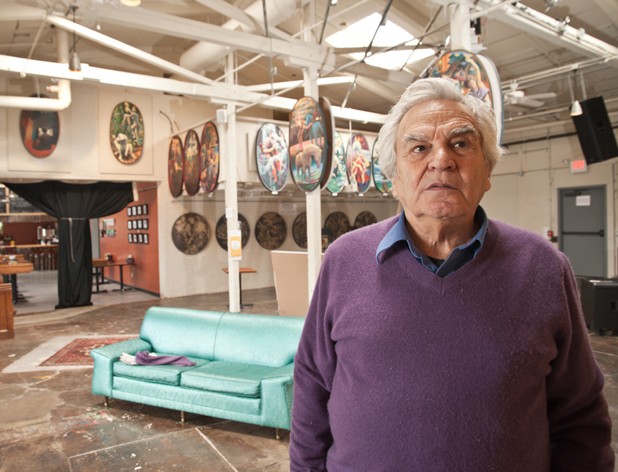
- Matthew Thorsen
- Al Salzman
Donald Rumsfeld and Dick Cheney sneeringly dunk a naked man into a tub of water. Skeletal air traffic controllers direct drone attacks on petrified Muslim women. A passel of presidents, past and present, confidently mount a bloody-eyed, broken-backed soldier. These are just a few of the uncompromising, ripped-from-the-headlines tableaux in Al Salzman’s new exhibit, “Subversive,” at Burlington’s ArtsRiot gallery.
Perhaps “arresting” is the best word for his artwork, which employs bold, even garish, colors; editorial-cartoon techniques; and freeform text and images to communicate Salzman’s political views.
Salzman, 80, a longtime resident of Fairfield, defines himself as “a leftist — a socialist, essentially,” but perhaps he’s putting it too mildly. Even a quick perusal of his work suggests that the artist would be satisfied with nothing less than a complete overhaul of the political system. “Most of my artwork is unabashedly propagandistic,” he says with evident glee.
Like most propaganda, Salzman’s artwork is not subtle — the better to instill in its viewers a sense of political outrage. But behind his overt imagery is technique that evokes German Expressionism. Max Beckmann, George Grosz and Otto Dix are among his inspirations, both for their stark depictions and their political conscience. Salzman admires how these artists — who came of age in the early 20th century — used their medium to “comment on the militaristic junta mentality that was gaining roots in Germany between the two wars,” he says.
And there is another, unexpected influence on the works in “Subversive.” All of the paintings are presented in unusually shaped frames — most oval, some circular. “Rectangles and squares have ‘dead corners,’ and ovals do not,” Salzman explains. His use of this tondo framing, commonly employed in Renaissance paintings, is more than a compositional strategy: It’s also one way in which Salzman gives his work a religious undertone.
In their titles and content, too, the paintings use religion as an ironic context for scenes of injustice. “Via Dolorosa” depicts New York City cops abusing a young black man — Salzman’s commentary on the city’s controversial “stop and frisk” policy.
Another work, “Mea Maxima Culpa,” is even more irreligious. It depicts a sweaty, pig-faced Catholic cardinal praying, his eyes to the heavens. In front of him is a young, naked boy; above, a band of angels angrily points accusing fingers at him. “The pedophilia scandal in the Catholic Church is outrageous,” Salzman declaims. “They should have been prosecuted under RICO [Racketeer Influenced and Corrupt Organizations Act] laws.”
Just a few years ago, Salzman retired from teaching art in public school, where, he says, he ran his classroom as if it were an atelier. “I’d introduce a project to the kids, and I would always work alongside them, so they could see my process, as well,” he says. He also made a point of using public-school tempera paint to create his works. “I figured, if I’m going to teach art, I would do my own work with the same medium as the kids, to see how far I could stretch it.”
“Subversive” was curated just within the last month. Driving down Pine Street one day, Salzman found himself attracted to the words “DESTROY APATHY” emblazoned on the exterior of the ArtsRiot building.
“Al just busted in here, told us he loved that, and that he was going to send me some artwork,” says curator Hillary Clark, 23. “‘Destroy Apathy’ can seem at first a little violent and negative,” she says, “but it’s really uplifting and empowering people to acknowledge that there is a problem … and to try to fight against it.”
Salzman brought his work for Clark’s consideration; soon thereafter, she decided his paintings were well suited for a show in ArtsRiot’s gallery. “One thing immediately excited me about Al: He had a clear and distinct statement,” Clark says.
The ArtsRiot staff blocked off a couple of windows with custom panels to accommodate the nearly 50 paintings in the show. Some of Salzman’s poems, which are just as incendiary as his visual art, are also displayed. In both his written and painted work, Salzman lets no one off the hook. He clearly has no love for George W. Bush, but he’s especially disappointed by Barack Obama, who, he says, has perpetuated “the most egregious policies of the Bush administration.”
The show is not all Sturm und Drang, though. The “Humandalas” series — charcoal drawings hung in their own “wing” of the gallery — stands out not just for its monochromatic palette, but because its imagery evokes shared human experiences rather than political oppression.
Surprisingly, viewers will also find a couple of paintings of skateboarders.
“I love skateboarders,” Salzman says. “I think skateboarders are like angels.”
His paintings of ’boarders celebrate their athletic grace and easy movements. But, as with everything else in this show, there’s a political angle.
“If it were up to me, I’d ban cars from inner Burlington and allow only skaters, bikers and Rollerbladers,” Salzman says, before unleashing his genial invective against automobile emissions, the capitalist conspiracy behind traffic congestion and the sensory overload and overpopulation that have made New York City nearly unlivable.
For Salzman and his artwork, the aesthetic and the political are inseparable.
The original print version of this article was headlined "Painting Politic"
“Subversive” by Al Salzman, ArtsRiot, Burlington. Through January 17. Reception, Friday, November 15, at 6:30 p.m. artsriot.com




Comments
Comments are closed.
From 2014-2020, Seven Days allowed readers to comment on all stories posted on our website. While we've appreciated the suggestions and insights, right now Seven Days is prioritizing our core mission — producing high-quality, responsible local journalism — over moderating online debates between readers.
To criticize, correct or praise our reporting, please send us a letter to the editor or send us a tip. We’ll check it out and report the results.
Online comments may return when we have better tech tools for managing them. Thanks for reading.